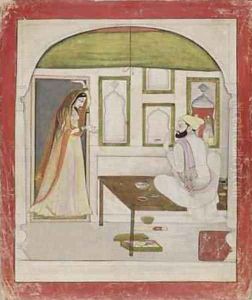Son of Manaku Paintings
The artist known as the Son of Manaku represents an enigmatic yet significant figure in the history of Indian art, specifically within the Pahari painting tradition of the 18th century. His exact birth and death dates are not documented, and much of what we know about him derives from the study of his stylistic contributions and familial lineage. As his title suggests, he was the son of Manaku, a renowned painter from Guler, a small princely state in the Pahari region, which is today part of Himachal Pradesh, India. This area was a vibrant center for the development of a distinctive school of miniature painting from the 17th to the 19th centuries, characterized by its intricate detailing, vivid colors, and expressive portrayal of religious and mythological themes.
The Son of Manaku, like his father, was deeply embedded in the cultural and artistic milieu of Guler. The familial connection to Manaku, who along with his brother Nainsukh (another celebrated painter), played a pivotal role in the evolution of Pahari painting, provided him with a rich legacy and a foundation upon which to build his own artistic identity. However, distinct from the shadow of his father's and uncle's towering legacies, the Son of Manaku developed his own unique style. He is believed to have been active primarily in the 1730s, a period that saw the flourishing of Pahari painting under the patronage of local rulers and the growing influence of Vaishnavism, which often depicted scenes from the life of Krishna.
Although specific works attributed directly to the Son of Manaku are scarce, those that are, exhibit a keen attention to the nuances of facial expressions and the natural world, suggesting a continuity yet evolution of the family's artistic talents. His works are often analyzed through comparisons with those of his father, revealing both adherence to and deviations from established familial and regional styles. This has allowed historians and art connoisseurs to appreciate the subtle blend of tradition and personal innovation that he brought to the art form.
The legacy of the Son of Manaku is intertwined with the broader narrative of Pahari painting, reflecting both the continuation of a family's artistic dynasty and the individual artist's contribution to the genre's development. Despite the scarcity of biographical details, his work contributes to our understanding of the dynamics of artistic production, inheritance, and innovation in the Pahari courts. Through the surviving paintings attributed to him and his family, we gain insight into the rich cultural and religious life of 18th-century North India, as well as the complex interplay of individual talent and familial legacy in the history of art.
